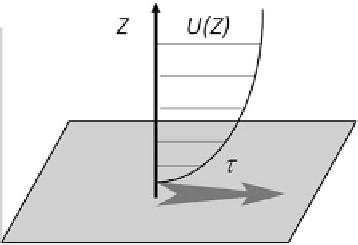Geoscience Reference
In-Depth Information
Fig. 5.1
Schematic
representation of the surface
wind shear stress and of the
vertical profile of wind
velocity (Alfaro
1997
)
in air potential temperature), the wind velocity can be expressed by a logarithmic
profile (Priestley
1959
):
U
k
ln .
z
=Z
0
/
D
for
z
>Z
0
; U
z
/
(5.3)
with
k
the von Karman constant (
0.4) and
Z
0
the aerodynamic roughness length.
The momentum partitioning due to roughness elements leads to a decrease of
the wind shear stress acting on the erodible surface and thus an apparent increase
of the threshold wind friction velocity
U
t
. Finally,
U
t
is generally expressed as a
combination of a size-dependent term weighted by additional functions describing
the influence of surface roughness, soil moisture or other environmental factors (e.g.
snow).
Once in motion, the movement of a soil particle depends on its size, shape
and density, being controlled by the balance between its terminal fall velocity and
the air vertical velocity. The largest or heaviest particles (approx.
D
p
> 1,000 m)
generally move along the surface with a creeping motion. Particles with diameters
between 70 and 1,000 m are entrained in a saltating motion: they are ejected from
the surface, follow a ballistic trajectory and finally impact the surface downwind.
These impacts eject other particles that follow a similar saltation motion. The total
amount of material mobilised by the wind in this horizontal movement depends
mainly on
U
*
and the size of the soil particles.
Theoretically, dust particles can directly be lifted from the surface by aero-
dynamic entrainment (Fig.
5.2
, top panel). However, wind-tunnel measurements
performed on a dust bed show that such a direct entrainment requires very high
U
*
(
D
0.6-1 m s
1
) and that the resulting dust fluxes are one order of magnitude lower
than those measured in the field (Loosemore and Hunt
2000
). On the opposite, as
saltating particles hit the surface, their impacts are strong enough to overcome the
binding forces acting upon dust particles, leading to dust emission (Fig.
5.2
, middle
panel). This mechanism is also known as sandblasting (Gomes et al.
1990
;Alfaro
et al.
1997
). The released particles can originate either from the impacted surface
or from the disaggregation of the saltating soil grains (Fig.
5.2
, bottom panel). This
process is also called “auto-abrasion” (Warren et al.
2007
). Recent field campaigns

Search WWH ::

Custom Search